Evolution of Annealing Twins in a Hot Deformed Nickel-Based Superalloy
Abstract
:1. Introduction
2. Materials and Experimental Procedure
3. Results and Discussion
3.1. Initial Microstructure
3.2. Hot Deformation Behavior
3.3. Dynamic Recrystallization Behavior
3.4. Effects of Deformation Parameters on the Evolution of Annealing Twins
3.4.1. Effects of Strain
3.4.2. Effects of Deformation Temperature
3.4.3. Effects of Strain Rate
3.5. The Role of Annealing Twins on DRX
3.5.1. The Role of Initial Annealing Twins
3.5.2. The Role of Newly-Formed Annealing Twins
4. Conclusions
- (1)
- The peak stress becomes indistinct and exhibits a plateau at lower deformation temperatures and strain rate, showing typical work hardening, dynamic recovery, and dynamic recrystallization features. Because the dynamic softening at low deformation temperature or high strain rate is intense, a large difference between the peak and yield stresses can be observed.
- (2)
- The evolution of annealing twin is sensitively affected by deformation parameters. At the beginning of deformation, the initial annealing twins are easy to disappear due to the rotation of grains. New annealing twins form on the DRX grain boundaries or within DRX grains with the increased strain. It indicates the grain boundary migration during the growth of DRX grains can promote the formation of annealing twins. At high deformation temperatures or low strain rates, DRX is accelerated. Accordingly, the fractions of annealing twin boundaries significantly increases.
- (3)
- The annealing twins play a vital role in the nucleation of DRX. The initial annealing twins easily lose their character due to the rotation of grains during hot deformation, providing an extra driving force for the DRX nucleation. In addition, it can be transformed into considerable mobile grain boundaries of new DRX nucleation. Besides, fresh annealing twins, which emerge at DRX grain boundaries or the interior of DRX grains, can accelerate the separation of bulging nuclei from the initial grains.
Author Contributions
Funding
Institutional Review Board Statement
Informed Consent Statement
Data Availability Statement
Conflicts of Interest
References
- Wang, G.Q.; Chen, M.S.; Lin, Y.C.; Lou, Y.M.; Li, H.B.; Ma, Y.Y.; Zou, Z.H.; Chen, Q.; Xia, Y.C. Effects of double-stage annealing parameters on tensile mechanical properties of initial aging deformed GH4169 superalloy. Materials 2021, 14, 4339. [Google Scholar] [CrossRef]
- Ma, W.; Luo, H.; Yang, X. The effects of grain size and twins density on high temperature oxidation behavior of nickel based superalloy GH738. Materials 2020, 13, 4166. [Google Scholar] [CrossRef]
- Sekine, M.; Sakaguchi, N.; Endo, M.; Kinoshita, H.; Watanabe, S.; Kokawa, H.; Yamashita, S.; Yano, Y.; Kawai, M. Grain boundary engineering of austenitic steel PNC316 for use in nuclear reactors. J. Nucl. Mater. 2011, 414, 232–236. [Google Scholar] [CrossRef] [Green Version]
- Shi, H.; Chen, K.; Shen, Z.; Wu, J.Q.; Dong, X.Q.; Zhang, L.T.; Shan, A.D. Twin boundary characters established during dynamic recrystallization in a nickel alloy. Mater. Charact. 2015, 110, 52–59. [Google Scholar] [CrossRef]
- Li, B.; Tin, S. The role of deformation temperature and strain on grain boundary engineering of Inconel 600. Mater. Sci. Eng. A 2014, 603, 104–113. [Google Scholar] [CrossRef]
- Hanning, F.; Engelberg, D.L. Metallographic screening of grain boundary engineered type 304 austenitic stainless steel. Mater. Charact. 2014, 94, 111–115. [Google Scholar] [CrossRef]
- Tikhonova, M.; Kaibyshev, R.; Fang, X.; Wang, W.; Belyakov, A. Grain boundary assembles developed in an austenitic stainless steel during large strain warm working. Mater. Charact. 2012, 70, 14–20. [Google Scholar] [CrossRef]
- Brandon, D. The structure of high-angle grain boundaries. Acta Metall. 1966, 14, 1479–1484. [Google Scholar] [CrossRef]
- Liu, T.G.; Xia, S.; Li, H.; Zhou, B.X.; Bai, Q. The highly twinned grain boundary network formation during grain boundary engineering. Mater. Lett. 2014, 133, 97–100. [Google Scholar] [CrossRef]
- Gutierrez-Urrutia, I.; Zaefferer, S.; Raabe, D. The effect of grain size and grain orientation on deformation twinning in a Fe–22 wt.% Mn–0.6 wt.% C TWIP steel. Mater. Sci. Eng. A 2010, 527, 3552–3560. [Google Scholar] [CrossRef]
- Khoddam, S.; Beladi, H.; Hodgson, P.D.; Zarei-Hanzaki, A. Surface wrinkling of the twinning induced plasticity steel during the tensile and torsion tests. Mater. Des. 2014, 60, 146–152. [Google Scholar] [CrossRef]
- Jin, Y.; Lin, B.; Bernacki, M.; Rohrer, G.S.; Rollett, A.D.; Bozzolo, N. Annealing twin development during recrystallization and grain growth in pure nickel. Mater. Sci. Eng. A 2014, 597, 295–303. [Google Scholar] [CrossRef] [Green Version]
- Chen, X.P.; Li, L.F.; Sun, H.F.; Wang, L.X.; Liu, Q. Studies on the evolution of annealing twins during recrystallization and grain growth in highly rolled pure nickel. Mater. Sci. Eng. A 2015, 622, 108–113. [Google Scholar] [CrossRef]
- Mirzadeh, H.; Cabrera, J.M.; Najafizadeh, A.; Calvillo, P.R. EBSD study of a hot deformed austenitic stainless steel. Mater. Sci. Eng. A 2012, 538, 236–245. [Google Scholar] [CrossRef]
- Cao, Y.; Di, H.S.; Zhang, J.Q.; Zhang, J.C.; Ma, T.J.; Misra, R.D.K. An electron backscattered diffraction study on the dynamic recrystallization behavior of a nickel–chromium alloy (800H) during hot deformation. Mater. Sci. Eng. A 2013, 585, 71–85. [Google Scholar] [CrossRef]
- Zhao, M.; Zhao, Z.; Liu, L.; Luo, G.; Chen, W. Influence of heat treatment on cyclic response of nickel-based superalloy inconel 718 up to very-high cycle regime. Materials 2020, 13, 5358. [Google Scholar] [CrossRef] [PubMed]
- Zhang, C.; Yu, L.; Wang, H. Kinetic analysis for high-temperature coarsening of γ phase in Ni-based superalloy GH4169. Materials 2019, 12, 2096. [Google Scholar] [CrossRef] [Green Version]
- Guo, C.; Yu, J.; Liu, J.; Sun, X.; Zhou, Y. Tensile deformation and fracture behavior of nickel-based superalloy DZ951G. Materials 2021, 14, 2250. [Google Scholar] [CrossRef] [PubMed]
- Zhang, H.Y.; Zhang, S.H.; Cheng, M.; Li, Z.X. Deformation characteristics of δ phase in the delta-processed Inconel 718 alloy. Mater. Charact. 2010, 61, 49–53. [Google Scholar] [CrossRef]
- Wen, D.X.; Lin, Y.C.; Chen, J.; Chen, X.M.; Zhang, J.L.; Liang, Y.J.; Li, L.T. Work-hardening behaviors of typical solution-treated and aged Ni-based superalloys during hot deformation. J. Alloys Compd. 2015, 618, 372–379. [Google Scholar] [CrossRef]
- Wen, D.X.; Lin, Y.C.; Chen, J.; Deng, J.; Chen, X.M.; Zhang, J.L.; He, M. Effects of initial aging time on processing map and microstructures of a nickel-based superalloy. Mater. Sci. Eng. A 2015, 620, 319–332. [Google Scholar] [CrossRef]
- Ning, Y.Q.; Fu, M.W.; Chen, X. Hot deformation behavior of GH4169 superalloy associated with stick δ phase dissolution during isothermal compression process. Mater. Sci. Eng. A 2012, 540, 164–173. [Google Scholar] [CrossRef]
- Chen, X.M.; Lin, Y.C.; Wen, D.X.; Zhang, J.L.; He, M. Dynamic recrystallization behavior of a typical nickel-based superalloy during hot deformation. Mater. Des. 2014, 57, 568–577. [Google Scholar] [CrossRef]
- Liu, Y.X.; Lin, Y.C.; Li, H.B.; Wen, D.X.; Chen, X.M.; Chen, M.S. Study of dynamic recrystallization in a Ni-based superalloy by experiments and cellular automaton model. Mater. Sci. Eng. A 2015, 626, 432–440. [Google Scholar] [CrossRef]
- Shore, F.M.; Morakabati, M.; Abbasi, S.M.; Momeni, A.; Mahdavi, R. Hot ductility of incoloy 901 produced by vacuum arc remelting. ISIJ Int. 2014, 54, 1353–1360. [Google Scholar] [CrossRef] [Green Version]
- Li, D.F.; Guo, Q.M.; Guo, S.L.; Peng, H.J.; Wu, Z.G. The microstructure evolution and nucleation mechanisms of dynamic recrystallization in hot-deformed Inconel 625 superalloy. Mater. Des. 2011, 32, 696–705. [Google Scholar] [CrossRef]
- Wang, Y.; Shao, W.Z.; Zhen, L.; Zhang, X.M. Microstructure evolution during dynamic recrystallization of hot deformed superalloy 718. Mater. Sci. Eng. A 2008, 486, 321–332. [Google Scholar] [CrossRef]
- Chong, Y.; Liu, Z.D.; Godfrey, A.; Liu, W.; Weng, Y.Q. The application of grain boundary engineering to a nickel base superalloy for 973 k (700 °C) USC power plants. Metall. Mater. Trans. E 2014, 1, 58–66. [Google Scholar] [CrossRef] [Green Version]
- Wen, D.X.; Lin, Y.C.; Li, H.B.; Chen, X.M.; Deng, J.; Li, L.T. Hot deformation behavior and processing map of a typical Ni-based superalloy. Mater. Sci. Eng. A 2014, 591, 183–192. [Google Scholar] [CrossRef]
- Liu, Y.H.; Ning, Y.Q.; Yao, Z.K.; Guo, H.Z.; Nan, Y. Effect of true strains on processing map for isothermal compression of Ni–20.0Cr–2.5Ti–1.5Nb–1.0Al Ni-base superalloy. J. Alloys Compd. 2014, 612, 56–63. [Google Scholar] [CrossRef]
- Shen, J.Y.; Hu, L.X.; Sun, Y.; Feng, X.Y.; Fang, A.W.; Wan, Z.P. Hot deformation behaviors and three-dimensional processing map of a nickel-based superalloy with initial dendrite microstructure. J. Alloys Compd. 2020, 822, 153735. [Google Scholar] [CrossRef]
- Zhang, J.B.; Wu, C.J.; Peng, Y.Y.; Xia, X.C.; Li, J.G.; Ding, J.; Liu, C.; Chen, X.G.; Dong, J.; Liu, Y.C. Hot compression deformation behavior and processing maps of ATI 718Plus superalloy. J. Alloys Compd. 2020, 835, 155195. [Google Scholar] [CrossRef]
- Zhang, C.; Zhang, L.; Shen, W.; Xu, Q.; Cui, Y. The processing map and microstructure evolution of Ni-Cr-Mo-based C276 superalloy during hot compression. J. Alloys Compd. 2017, 728, 1269–1278. [Google Scholar] [CrossRef]
- Chen, M.S.; Zou, Z.H.; Lin, Y.C.; Li, H.B.; Wang, G.Q.; Ma, Y.Y. Microstructural evolution and grain refinement mechanisms of a Ni-based superalloy during a two-stage annealing treatment. Mater. Charact. 2019, 151, 445–456. [Google Scholar] [CrossRef]
- Chai, L.J.; Luan, B.F.; Murty, K.L.; Liu, Q. Twinning during recrystallization cooling in α-Zr alloy. Mater. Sci. Eng. A 2013, 576, 320–325. [Google Scholar] [CrossRef]
- Randle, V. Mechanism of twinning-induced grain boundary engineering in low stacking-fault energy materials. Acta Mater. 1999, 47, 4187–4196. [Google Scholar] [CrossRef]
- Tschopp, M.A.; Coleman, S.P.; McDowell, D.L. Symmetric and asymmetric tilt grain boundary structure and energy in Cu and Al (and transferability to other fcc metals). Integ. Mater. Manufact. Innov. 2015, 4, 176–189. [Google Scholar] [CrossRef] [Green Version]
- Randle, V. The influence of annealing twinning on microstructure evolution. J. Mater. Sci. 2005, 40, 853–859. [Google Scholar] [CrossRef]
- Lin, Y.C.; Wu, X.Y.; Chen, X.M.; Chen, J.; Wen, D.X.; Zhang, J.L.; Li, L.T. EBSD study of a hot deformed nickel-based superalloy. J. Alloys Compd. 2015, 640, 101–113. [Google Scholar] [CrossRef]
- Momeni, A.; Abbasi, S.M.; Morakabati, M.; Badri, H.; Wang, X. Dynamic recrystallization behavior and constitutive analysis of Incoloy 901 under hot working condition. Mater. Sci. Eng. A 2014, 615, 51–60. [Google Scholar] [CrossRef]
- Mitsche, S.; Sommitsch, C.; Huber, D.; Stockinger, M.; Poelt, P. Assessment of dynamic softening mechanisms in Allvac®718Plus™ by EBSD analysis. Mater. Sci. Eng. A 2011, 528, 3754–3760. [Google Scholar] [CrossRef]
- Cheng, H.; Lin, Y.C.; He, D.G.; Qiu, Y.L.; Zhu, J.C.; Chen, M.S. Influences of stress-aging on the precipitation behavior of δ phase (Ni3Nb) in a nickel-based superalloy. Mater. Des. 2021, 197, 109256. [Google Scholar] [CrossRef]
- Samantaray, D.; Mandal, S.; Jayalakshmi, M.; Athreya, C.N.; Bhaduri, A.K.; Sarma, V.S. New insights into the relationship between dynamic softening phenomena and efficiency of hot working domains of a nitrogen enhanced 316L (N) stainless steel. Mater. Sci. Eng. A 2014, 598, 368–375. [Google Scholar] [CrossRef]
- Chen, Z.J.; Lin, Y.C.; He, D.G.; Lou, Y.M.; Chen, M.S. A unified dislocation density-based model for an aged polycrystalline Ni-based superalloy considering the coupled effects of complicate deformation mechanisms and initial δ phase. Mater. Sci. Eng. A 2021, 827, 142062. [Google Scholar] [CrossRef]
- Wu, K.; Liu, G.Q.; Hu, B.F.; Li, F.; Zhang, Y.W.; Tao, Y.; Liu, J.T. Characterization of hot deformation behavior of a new Ni–Cr–Co based P/M superalloy. Mater. Charact. 2010, 61, 330–340. [Google Scholar] [CrossRef]
- Lin, Y.C.; Wen, D.X.; Chen, M.S.; Chen, X.M. A novel unified dislocation density based model for hot deformation behavior of a nickel-based superalloy under dynamic recrystallization conditions. Appl. Phys. A 2016, 122, 805. [Google Scholar] [CrossRef]
- Chen, M.S.; Li, K.K.; Lin, Y.C.; Yuan, W.Q. An improved kinetics model to describe dynamic recrystallization behavior under inconstant deformation conditions. J. Mater. Res. 2016, 31, 2994–3003. [Google Scholar] [CrossRef]
- Wang, M.J.; Sun, C.Y.; Fu, M.W.; Liu, Z.L.; Wang, C.H. Experimental investigations and constitutive modeling of the dynamic recrystallization behavior of Inconel 740 superalloy. Mater. Sci. Eng. A 2020, 793, 139939. [Google Scholar] [CrossRef]
- Xiong, Y.B.; Wen, D.X.; Li, J.J.; Wang, K.; Zheng, Z.Z. High-temperature deformation characteristics and constitutive model of an ultrahigh strength steel. Met. Mater. Int. 2021, 27, 3945–3958. [Google Scholar] [CrossRef]
- Long, P.; Wen, D.X.; Min, J.; Zheng, Z.Z.; Li, J.J.; Liu, Y.X. Microstructure evolution and mechanical properties of a wire-arc additive manufactured austenitic stainless steel: Effect of processing parameter. Materials 2021, 14, 1681. [Google Scholar] [CrossRef]
- Su, G.; Yun, Z.; Lin, Y.C.; He, D.G.; Zhang, S.; Chen, Z.J. Microstructure evolution and a unified constitutive model of Ti-55511 alloy compressed at stepped strain rates. Materials 2021, 14, 6750. [Google Scholar] [CrossRef] [PubMed]
- Jiang, Y.Q.; Lin, Y.C.; Wang, G.Q.; Pang, G.D.; Chen, M.S.; Huang, Z.C. Microstructure evolution and a unified constitutive model for a Ti-55511 alloy deformed in β region. J. Alloys Compd. 2021, 870, 59534. [Google Scholar] [CrossRef]
- Beladi, H.; Cizek, P.; Hodgson, P.D. Dynamic recrystallization of austenite in Ni-30 Pct Fe model alloy: Microstructure and texture evolution. Metall. Mater. Trans. A 2009, 40, 1175–1189. [Google Scholar] [CrossRef]
- Mandal, S.; Mishra, S.K.; Kumar, A.; Samajdar, I.; Sivaprasad, P.V.; Jayakumar, T.; Raj, B. Evolution and characterization of dynamically recrystallized microstructure in a titanium-modified austenitic stainless steel using ultrasonic and EBSD techniques. Philos. Mag. 2008, 88, 883–897. [Google Scholar] [CrossRef]
- Mirzadeh, H.; Najafizadeh, A. Hot deformation and dynamic recrystallization of 17-4 PH stainless steel. ISIJ Int. 2013, 53, 680–689. [Google Scholar] [CrossRef] [Green Version]
- Samantaray, D.; Mandal, S.; Phaniraj, C.; Bhaduri, A.K. Flow behavior and microstructural evolution during hot deformation of AISI Type 316 L(N) austenitic stainless steel. Mater. Sci. Eng. A 2011, 528, 8565–8572. [Google Scholar] [CrossRef]
- Wang, W.; Lartigue-Korinek, S.; Brisset, F.; Helbert, A.L.; Bourgon, J.; Baudin, T. Formation of annealing twins during primary recrystallization of two low stacking fault energy Ni-based alloys. J. Mater. Sci. 2015, 50, 2167–2177. [Google Scholar] [CrossRef]
- Pande, C.S.; Imam, M.A.; Rath, B.B. Study of annealing twins in FCC metals and alloys. Metall. Mater. Trans. A 1990, 21, 2891–2896. [Google Scholar] [CrossRef]
- Mandal, S.; Bhaduri, A.K.; Sarma, V.S. A study on microstructural evolution and dynamic recrystallization during isothermal deformation of a Ti-modified austenitic stainless steel. Metall. Mater. Trans. A 2011, 42, 1062–1072. [Google Scholar] [CrossRef]
- Favre, J.; Koizumi, Y.; Chiba, A.; Fabregue, D.; Maire, E. Deformation behavior and dynamic recrystallization of biomedical Co-Cr-W-Ni (L-605) alloy. Metall. Mater. Trans. A 2013, 44, 2819–2830. [Google Scholar] [CrossRef]
- Halfpenny, A.; Prior, D.J.; Wheeler, J. Analysis of dynamic recrystallization and nucleation in a quartzite mylonite. Tectonophysics 2006, 427, 3–14. [Google Scholar] [CrossRef]
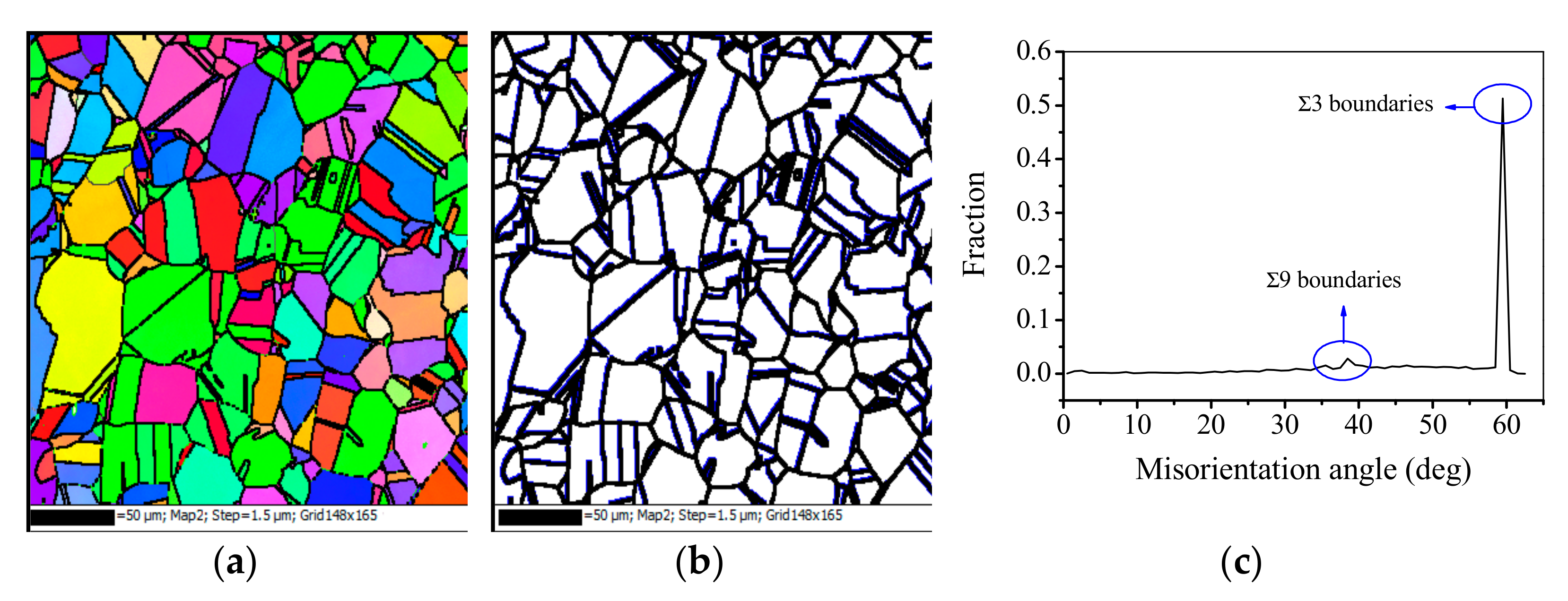
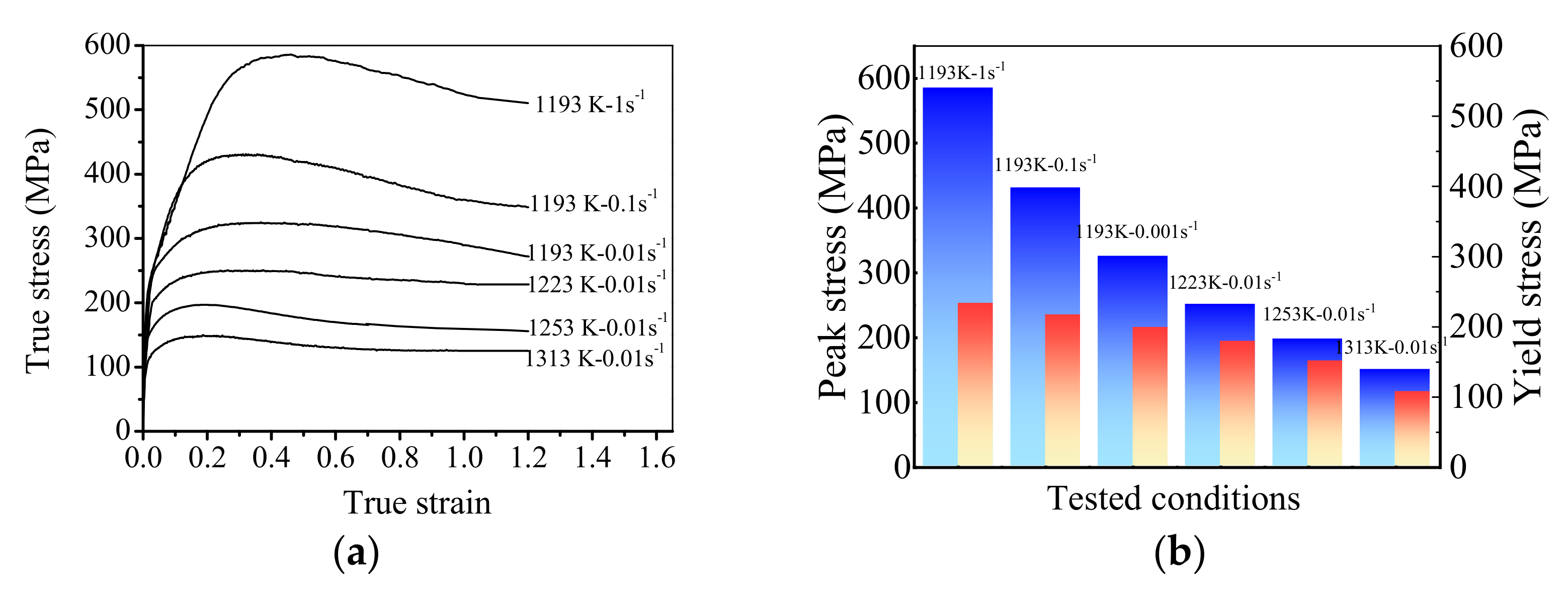

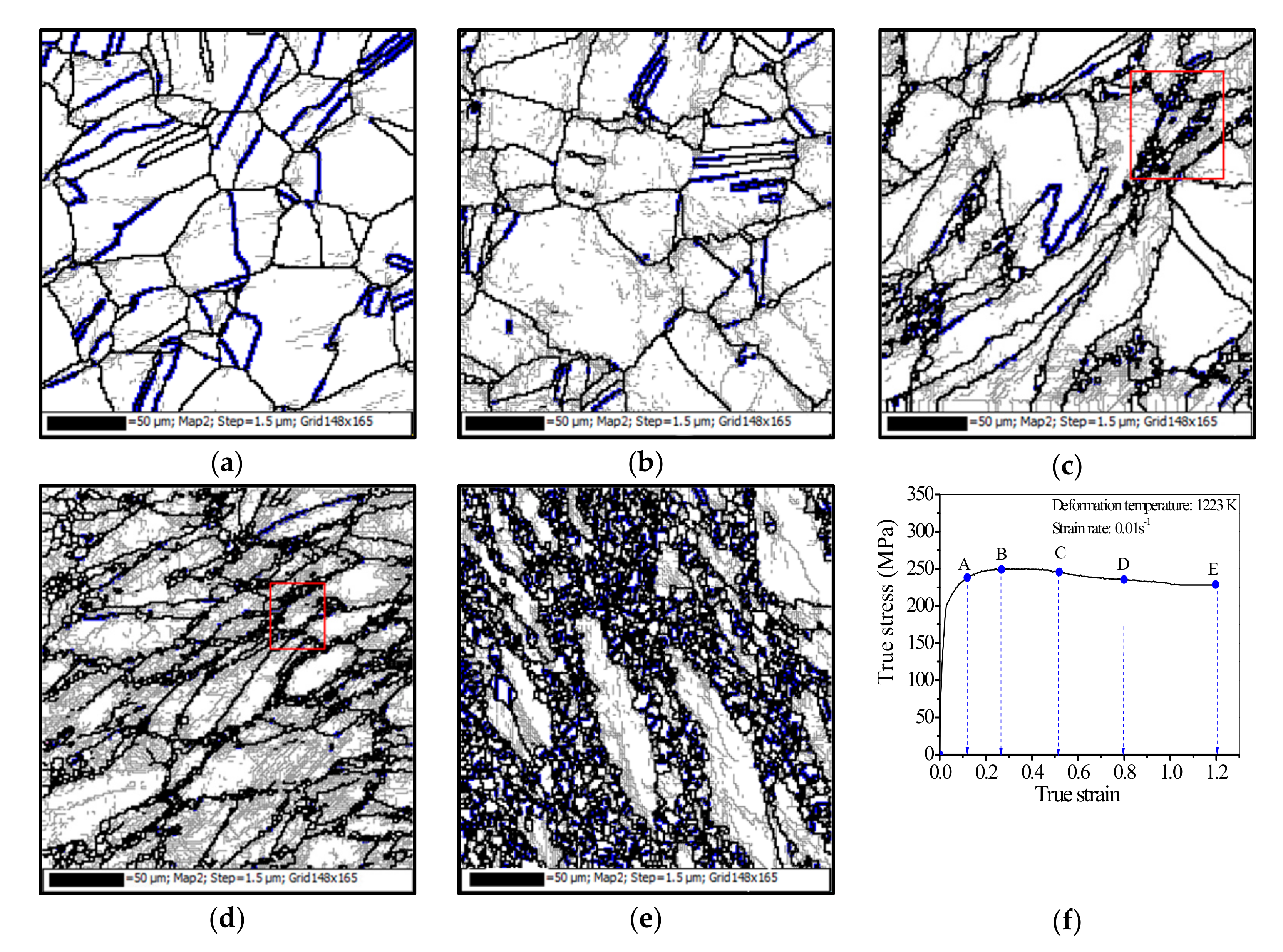
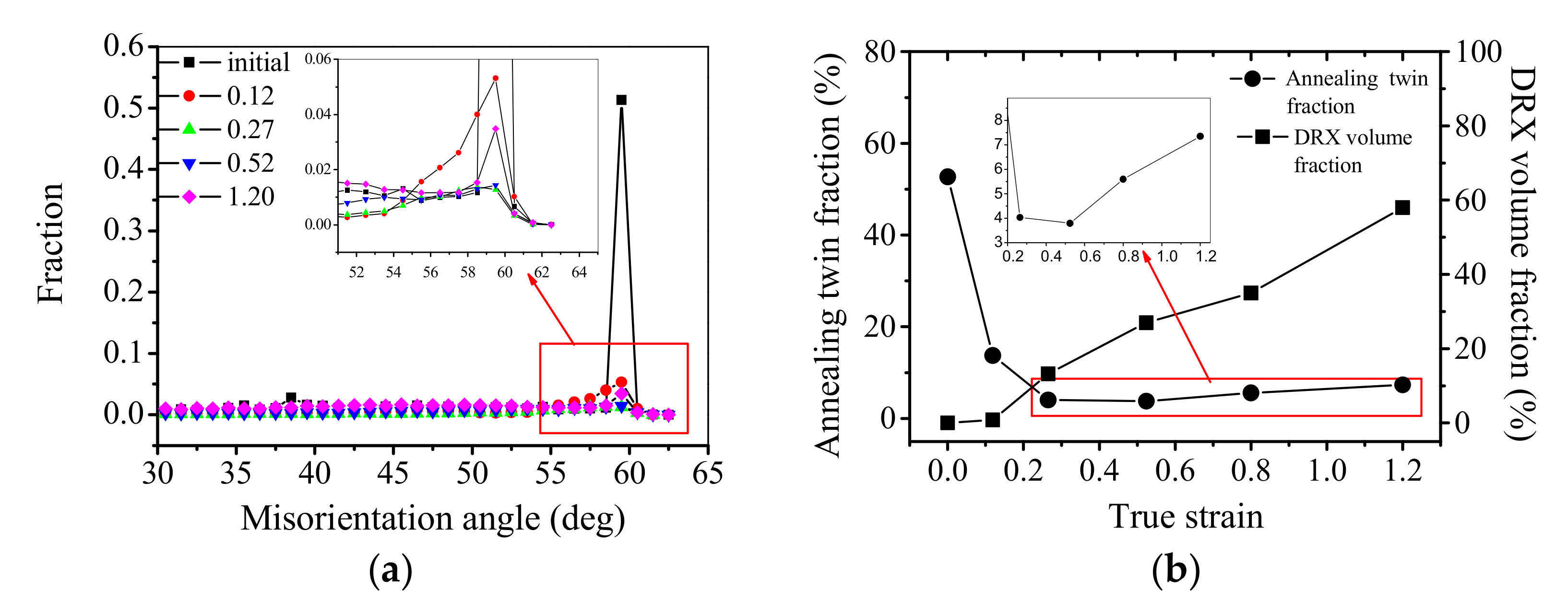
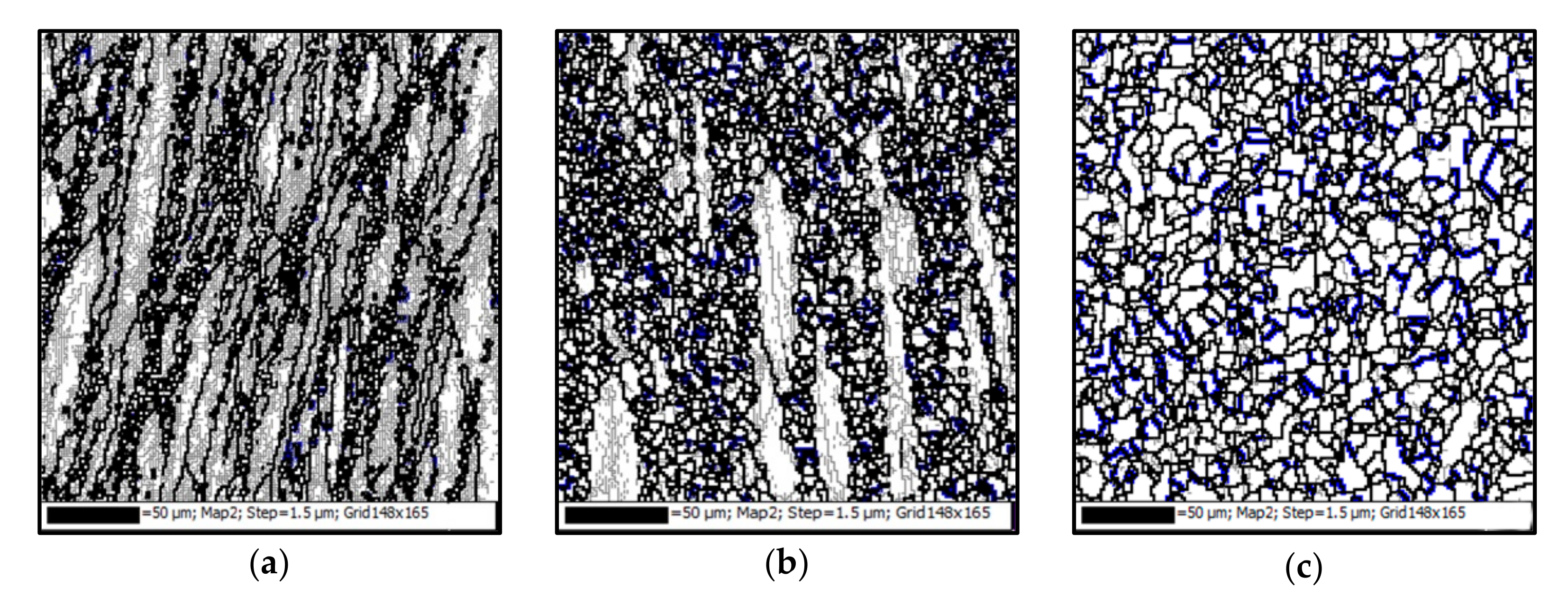
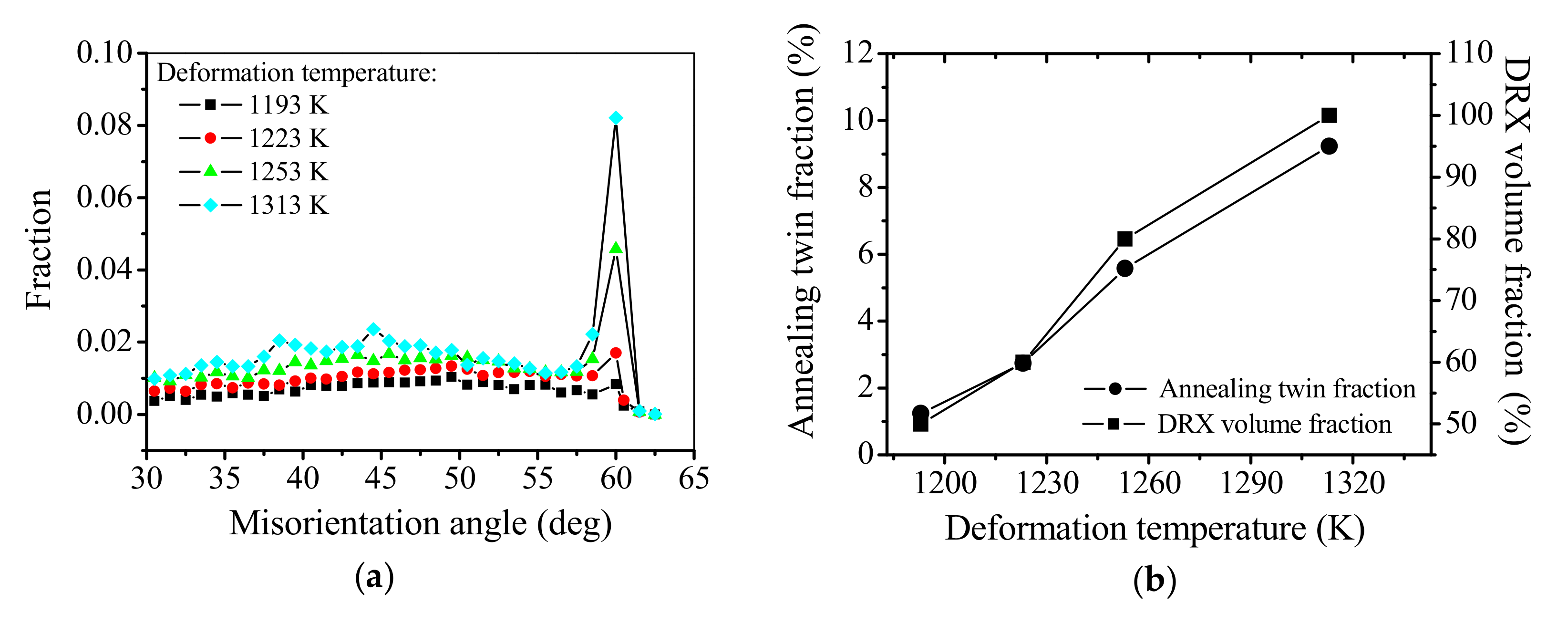
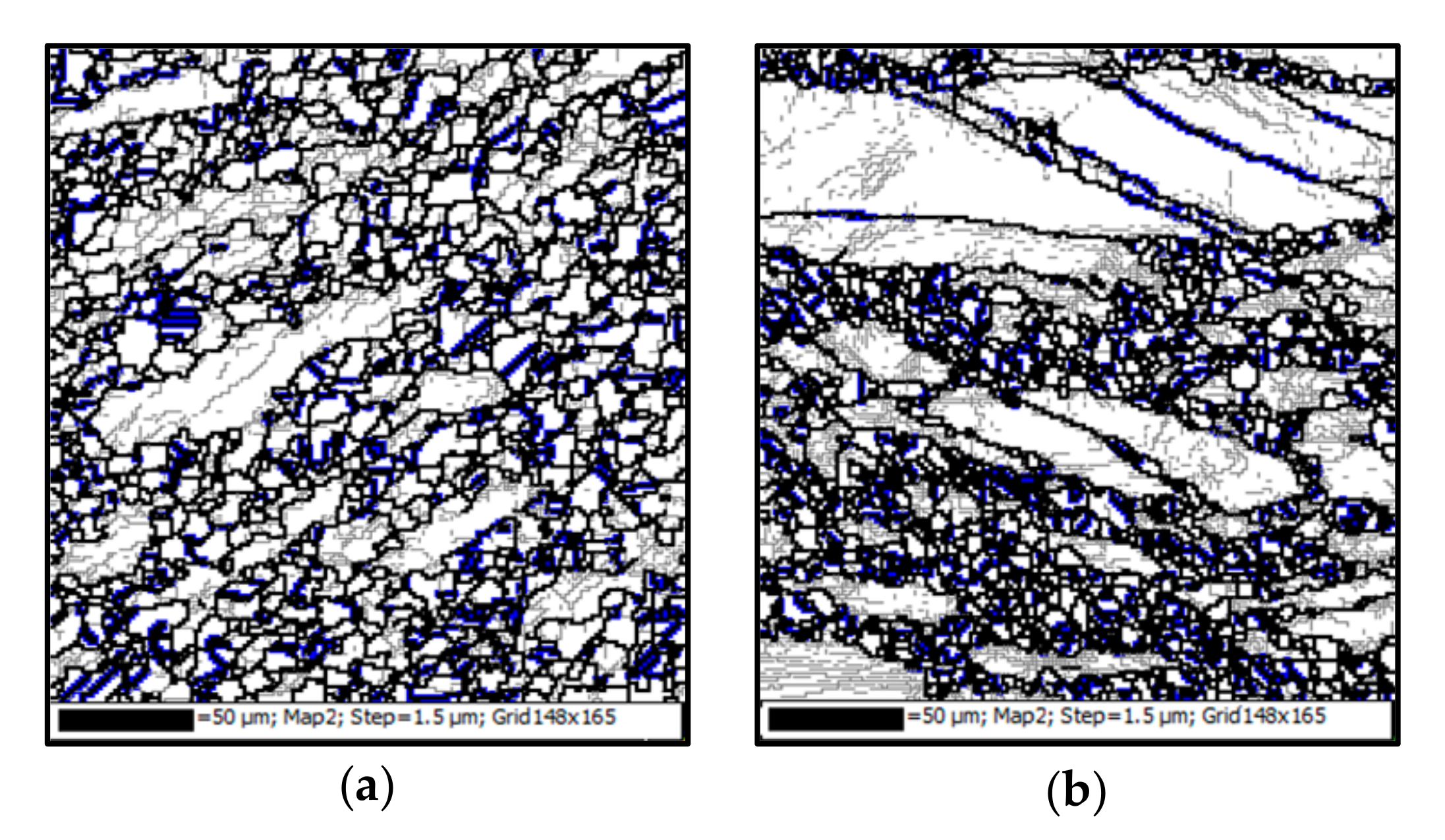
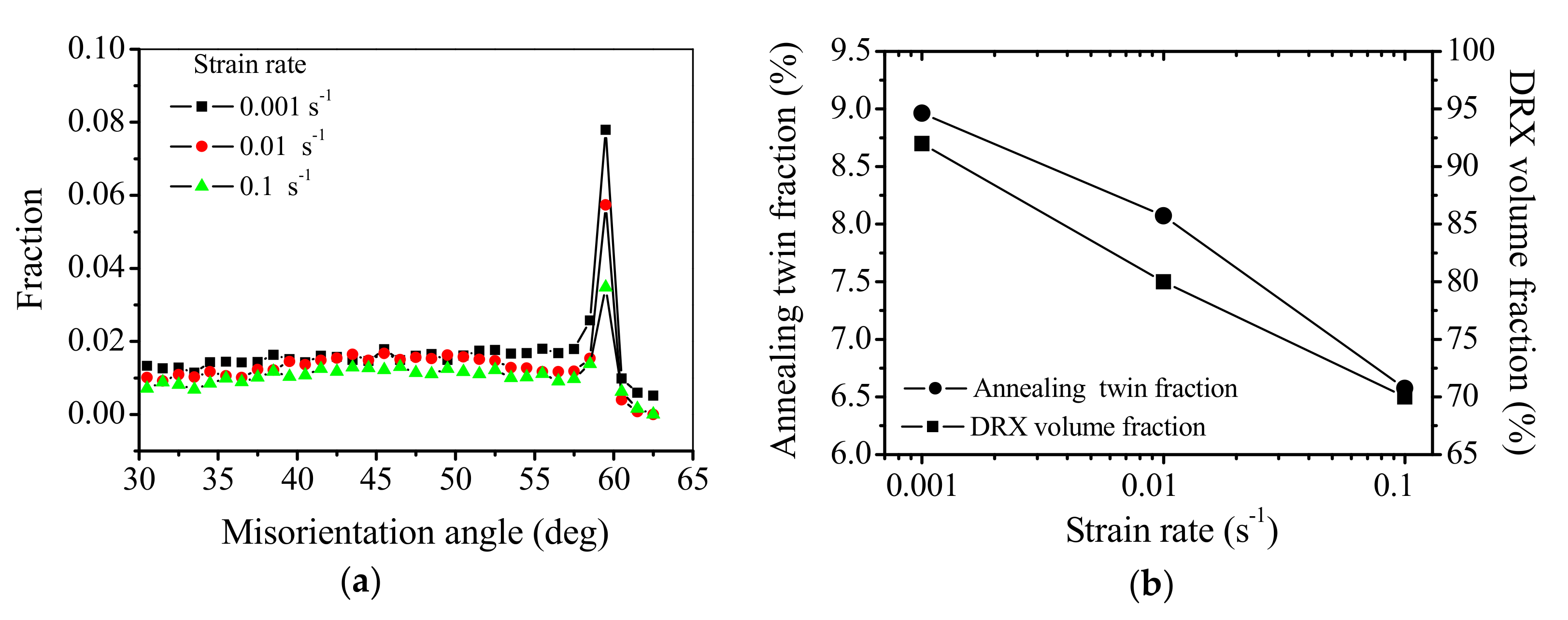
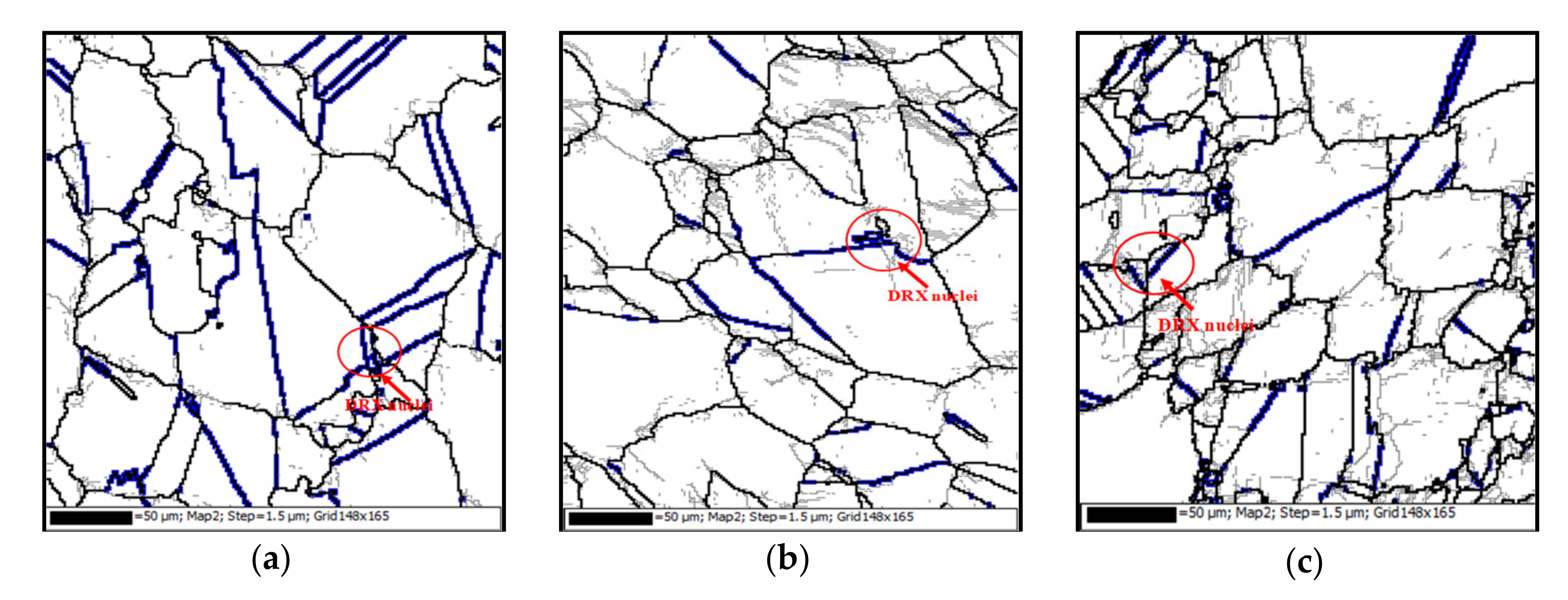


| Ni | Cr | Nb | Mo | Ti | Al | Co | C | Fe |
|---|---|---|---|---|---|---|---|---|
| 52.82 | 18.96 | 5.23 | 3.01 | 1.00 | 0.59 | 0.01 | 0.03 | Bal. |
Publisher’s Note: MDPI stays neutral with regard to jurisdictional claims in published maps and institutional affiliations. |
© 2021 by the authors. Licensee MDPI, Basel, Switzerland. This article is an open access article distributed under the terms and conditions of the Creative Commons Attribution (CC BY) license (https://creativecommons.org/licenses/by/4.0/).
Share and Cite
Xia, Y.-C.; Chen, X.-M.; Lin, Y.-C.; Lu, X.-Z. Evolution of Annealing Twins in a Hot Deformed Nickel-Based Superalloy. Materials 2022, 15, 7. https://doi.org/10.3390/ma15010007
Xia Y-C, Chen X-M, Lin Y-C, Lu X-Z. Evolution of Annealing Twins in a Hot Deformed Nickel-Based Superalloy. Materials. 2022; 15(1):7. https://doi.org/10.3390/ma15010007
Chicago/Turabian StyleXia, Yu-Chi, Xiao-Min Chen, Yong-Cheng Lin, and Xian-Zheng Lu. 2022. "Evolution of Annealing Twins in a Hot Deformed Nickel-Based Superalloy" Materials 15, no. 1: 7. https://doi.org/10.3390/ma15010007
APA StyleXia, Y. -C., Chen, X. -M., Lin, Y. -C., & Lu, X. -Z. (2022). Evolution of Annealing Twins in a Hot Deformed Nickel-Based Superalloy. Materials, 15(1), 7. https://doi.org/10.3390/ma15010007







